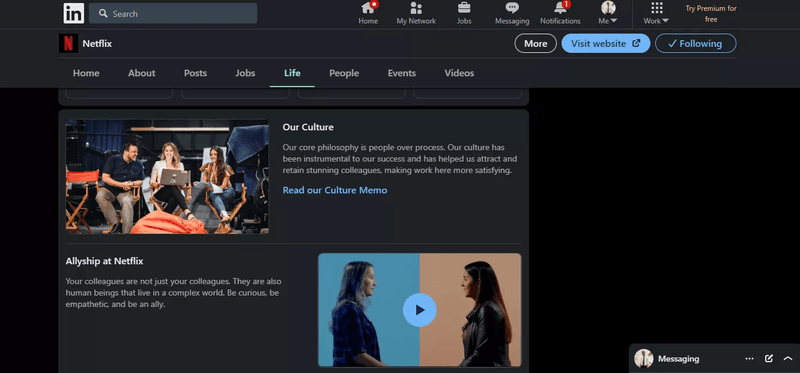
One of the most effective ways of showcasing your company culture to the rest of the world is by making company culture videos. However, it is quite easy to get them wrong and completely divert from your core message.

The best approach to highlighting your company in the recruitment market is to emphasize its culture.
Company culture sets the tone for your workplace and has a significant influence on employee happiness in their current position. It explains who you are and what you stand for to potential employers. It establishes expectations, making it easy to determine whether or not you're a good fit.
So, if you want to learn how to make effective culture videos for your company, keep reading.
Company culture videos are all about displaying your brand's culture and personality for prospects, customers, and future employees. They assist in showcasing a narrative for your brand so that people are enthusiastic to work with you or for you.
Candidates that are actively considering you as an employer might learn a lot about your company culture by watching videos.
Candidates can make better, more educated career selections if they are honest about what it's like to work at your firm. This translates to more employee engagement, lower turnover, and increased productivity and profit for the company.
Effective employee branding and talent marketing material allow the ideal applicants to create an emotional bond with your company's culture, converting viewers into committed candidates.
Candidates will imagine themselves as employees, roaming the hallways and experiencing those encounters with those stories as coworkers.
The advantages you'll get from your cultural video(s) may vary depending on the purpose for which you're making the film. For instance, a holiday video will have different goals and advantages than a recruitment video.
However, there are some common advantages that all culture videos provide. These include:
In the end, it's all about developing brand loyalty.
You want to demonstrate who you are as a brand and what you stand for so that people want to work with you because they know and like you. Video, more than any other media, allows you to communicate your culture more directly.
You may share your company culture videos with your audience in a ton of different ways. But which ones are the most effective?
Because of the targeting capabilities available on social media, cultural videos may be shared via social channels and social advertisements. Whatever the purpose of your video, you may reach the right audience on your own channels or through sponsored advertisements.
If your culture video is part of a recruitment campaign, be sure to post it on LinkedIn and other social media platforms.
Your email list also allows you to segment your audience, allowing you to share corporate culture videos with the individuals who are most likely to be interested.
In your customer acquisition process, a cultural video may be a wonderful complement to an early email. A culture video can be exactly the thing to keep a new subscriber on the path to becoming a client if they don't know you yet.
Your website is an excellent location for posting culture videos. However, you must select the appropriate part of your website based on the objectives of the cultural video you produce.
For instance, if you run a service-based company and your company culture video explains why people should work with you, it could make sense to put it on your site. However, if it's a recruitment video, the homepage isn't the best place to put it.
Your website's "About Us" section, as well as your "Careers" page and blog, are excellent places to include culture videos.
These videos mainly serve the purpose of showcasing your company's culture and work atmosphere, but these aren't just targeted at future employees. Before determining whether or not to collaborate with you, prospective customers and partners may want to learn more about your company culture.
Common ideas for workplace culture videos typically include "A day in the life" videos, in which you depict a typical day at work. Another example could be 'talking head' videos, in which you interview people, which are both excellent ideas for workplace culture videos.
About page videos try to accomplish the same goals as your about page texts but in a more friendly and digestible format.

It's a fantastic area to tell the narrative of your company's beginnings or to showcase any noteworthy achievements, honors, or statistics. You may also want to introduce some of your workers to put a human face on your company.
Workers, future employees, and new recruits are addressed directly in HR and recruitment videos.
Culture videos might be used for orientation, internal notifications, or workplace celebrations and achievements by a personnel team. Recruiting videos provide show what it's like to work at your firm to entice qualified candidates to apply.
Keep in mind that a recruitment video isn't only about showcasing your abilities. It's all about giving a clear image of your company's culture so you can attract applicants who will fit in well with your team.
The holidays are a fantastic time to be creative with your coworkers. These scripted videos are ideal for social media and may generate a lot of interest and exposure. Winter holidays and Halloween are popular choices, but other businesses find that videos for Mother's Day, Father's Day, and other occasions work well.
Your company stands for something - it isn’t just about revenue, lead conversions, or profit. Now, pinpointing what exactly your company’s identity is can be difficult. This seems like a vague concept, but we can simplify it using 4 metrics.
Every great business begins with a mission. Your mission is a brief and unambiguous description of your major, long-term goals that should drive every choice your company makes.
Consider how you'll achieve your goal once you've worked out your purpose. Your company's vision defines the desired impact on your community and industry.
These are the moral principles that your workers follow, as well as the behaviors that your firm represents. When your employees are in a bind, they may go to your business values for direction.
Your corporate culture is formed by combining your firm's vision, mission, and values. As a result, each culture is distinct from the others.
It is impossible to make an effective video by trying to tell too many stories at once. Make sure you don't overload your viewers. If you want visitors to have a clear picture of what you're all about, focusing on one or two core values is a good approach.
Unfortunately, not every facet of your business can be captured in a good video. Begin by determining which values are most appropriate for the compelling narrative you want to tell.
If you're going to recount the narrative of how your company got started, for example, look into why it all started. Finding a tale that is distinctively yours requires figuring out the "why”.
Remember that principles don't have to be blatantly unique; what matters is that they are genuine. They're also a team effort because a business is only as good as its people.
If you can clearly articulate the characteristics that distinguish your firm, your culture video will significantly benefit from expressing those values.
Even though your video will represent the day-to-day operations of your firm, you will need to prepare a polished script. One you'll use to lay out the framework of your film and direct the flow of the entire thing.
Utilizing the power of narrative is the key to writing a good script. We've been communicating via stories with real people and emotions since the dawn of time. Create a three-act framework for your message - a setup, a development, and a conclusion.
This is why you wanted to create a business culture video in the first place - to show your customers the emotional element of the products or services they like.
You'll almost certainly wind up with a callous video if you utilize actors. Ignore the likelihood that your audience may notice (which they will). What do you anticipate your workers' reactions will be?
The purpose of corporate culture videos is to provide an authentic look at your organization.
Approach employees in important departments that are relevant to the piece you're creating and ask if they'd want to participate, or ask them to pick a few people to represent them in the piece collectively.
If you're having trouble finding someone who reflects your corporate values, it's possible that those ideals aren't all that real, and you should reevaluate your approach.
Inserts and visuals combined with narration and interview recordings are used in the majority of culture videos. We'll deal with interviews later because they may be difficult. Let's start with the mechanics and bolts of putting together your cultural video.
We live in an age where technology is easily available, so acquiring the equipment you'll need to shoot your video shouldn't be a problem. There are, however, a few "tiers of entrance" via which you might approach this.
Obtaining all of this equipment above the basic level may be too expensive and unwise. Instead, try renting it or employing fully equipped video-producing services.
You'll also want to utilize motion graphics and inserts to tie the whole thing together, which you may outsource.
It's entirely up to you and your video's demands when it comes to recording places. Many culture videos incorporate footage from live events or active work environments. Interviews should be conducted in well-lit areas with few distractions.
Ideally, the interviewee should be framed from two angles: front and angled side. This enables you to change the angle of the finished piece and make it more dynamic.
If you're shooting on location, keep in mind that getting the gear and crew there might be difficult. If you want to record for more than a day, you'll also need to think about how you'll keep the equipment safe.
Asking and answering questions that begin with "Why?" is a wonderful method to define your brand narrative.
What motivates you to do what you do? What makes people want to collaborate with you? Why are your consumers so devoted to you? Why should anybody else be concerned about it? Apart from these, "Why do you work here?" is a good question to ask your workers.
Once you have the answers to these questions, you can create a video tale that exemplifies who you are as a business while also highlighting your mission. Then you can utilize your script to create a story that draws people closer to your business in a fun and engaging way.
A culture video must, above all, be truthful. Employees should not be forced to do or say things about their employer with which they do not completely agree.
For a sketch-type video, it's fine to write a line-by-line screenplay. However, if you're asking workers to speak about their own experiences, your script should be restricted to the questions you'll ask.
Make sure your video has the appropriate tone for your company. Don't claim to care about work-life balance if you're going to push workers to work a lot of overtime. Emphasize the qualities that make you appealing and distinctive.
It's not about your product - it's about your people and culture. Although your goods or services may feature in your video, this is not the place to explain why consumers should buy. Instead, you want to pique people's interests. A culture video should pique people's interest in learning more about your company.
Culture videos are valuable additions to your recruitment arsenal. The barrier to entry is minimal, thanks to a plethora of free video editing software programs for beginners. It's a one-of-a-kind method to introduce potential employees and others to your workplace.
However, if you want these videos to help you develop your brand, make sure you show off your company's individuality.
You're still employed by your employer for a reason. Allow your video to persuade future team members to follow suit. Most importantly, try to be as authentic as possible. It's the only way you'll get loyal employees and customers.
…. And scene!